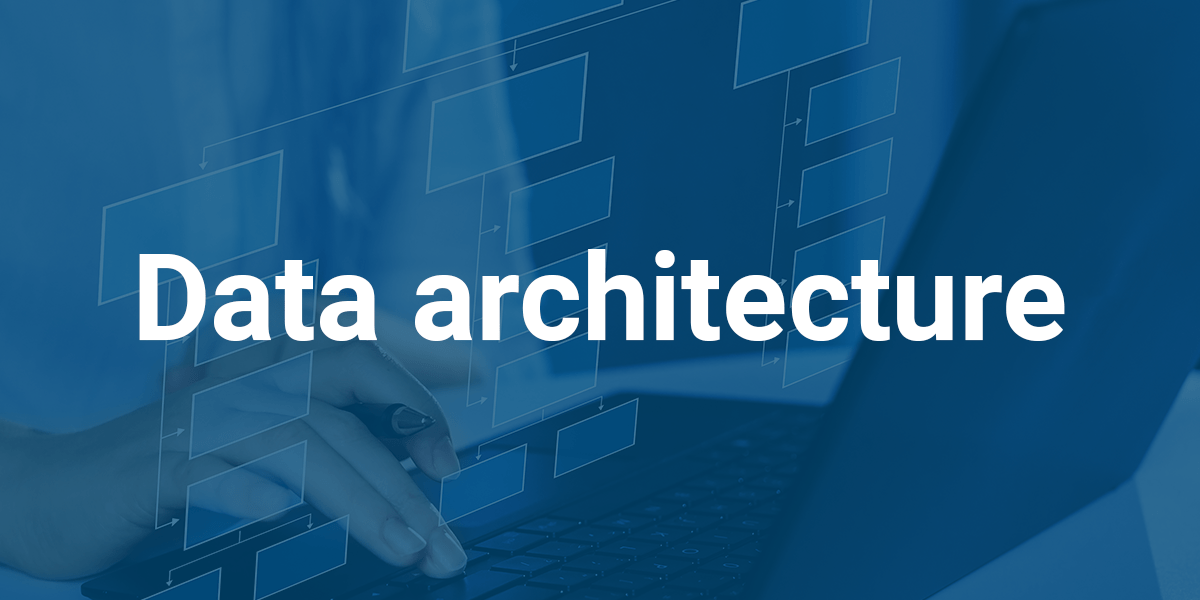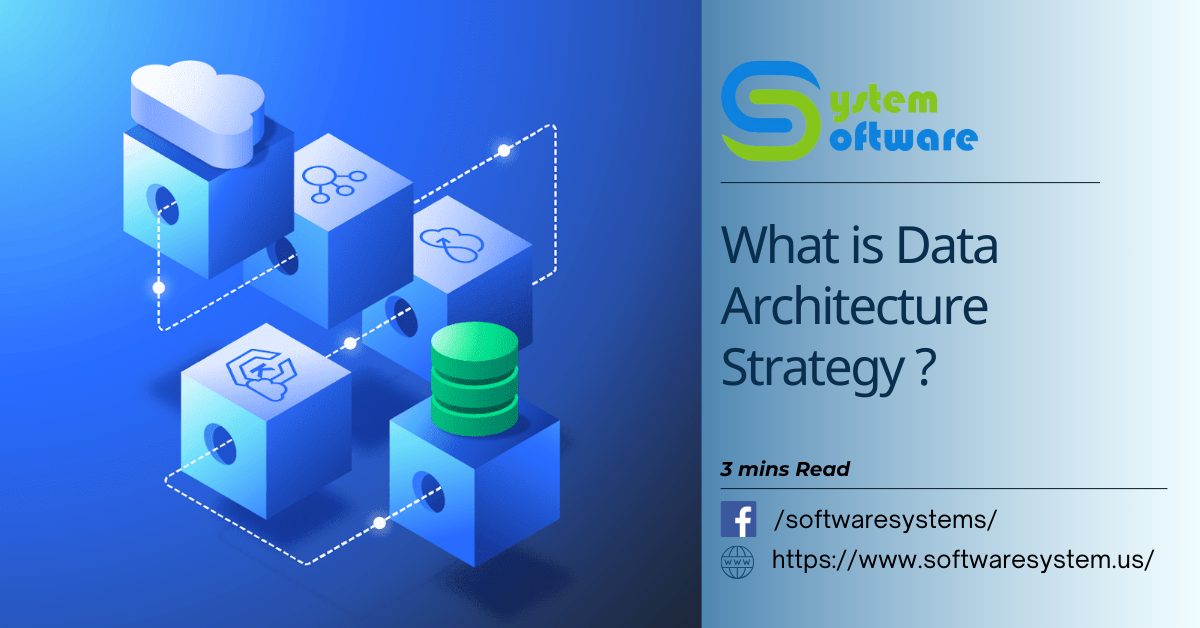Data architecture is the structural foundation that enables organizations to collect, store, manage, and utilize data effectively. It ensures data is organized, secure, and readily accessible, aligning technology infrastructure with business objectives to deliver actionable insights. In this article at Software Systems a Technology services company we will discover what is data architecture framework, data architecture strategy, and its role.
Think of data architecture as the central blueprint for how information flows within a company. It’s the strategic design that makes data accessible to the right people at the right time while safeguarding it from unauthorized access.
Table of Contents

What Is Data Architecture?
At its core, data architecture establishes a framework for handling data throughout its lifecycle from ingestion to processing, storage, and retrieval. The role of the data architect framework help transform raw data into meaningful insights that guide business decisions.
A well-constructed data architecture model integrates technical infrastructure with organizational needs, ensuring seamless data flow and enhanced decision-making capabilities.
9 Strategies for Building a Robust Data Architecture Framework
In a world where data fuels growth and innovation, crafting an efficient data architecture framework is critical. Below are nine proven strategies to design a framework that drives business success.
1. Understand Your Business Goals
Before diving into design, define your objectives. Do you want to streamline operations, enhance customer experiences, or optimize decision-making?
| Key Action Points | Outcome |
| Align stakeholders on priorities. | Ensures the framework meets organizational needs. |
| Set measurable objectives. | Guides the design and implementation process. |
A clear understanding of business goals ensures the architecture supports both immediate and long-term strategies.
2. Prioritize Data Quality
Data is only as valuable as its accuracy and relevance. Establishing strong validation protocols and regular cleansing processes prevents errors and inconsistencies from propagating.
| Best Practices | Benefit |
| Implement data validation tools. | Minimizes inaccuracies during data entry. |
| Schedule regular audits. | Maintains data integrity over time. |
Reliable data leads to informed decision-making and minimizes risks caused by flawed insights.
3. Opt for Scalability
Your architecture should grow with your business. Scalability ensures that increased data volumes don’t slow down processes or compromise efficiency.
| Considerations | Impact |
| Use cloud-based storage solutions. | Enables cost-effective, scalable data expansion. |
| Optimize processing workflows. | Ensures performance remains high under heavy loads. |
Scalable systems future-proof your operations against evolving business demands.
4. Ensure Interoperability
Modern businesses pull data from various sources, such as IoT devices, CRM platforms, and analytics tools. Seamless integration between these sources is crucial.
| Action Steps | Result |
| Leverage APIs for data sharing. | Facilitates smooth integration across platforms. |
| Adopt standard data formats. | Reduces complexity in merging diverse datasets. |
Interoperability streamlines data management, enabling unified insights from multiple channels.
5. Focus on Security
Data breaches can devastate a business. Implementing robust security measures is non-negotiable.
| Security Practices | Benefit |
| Encrypt data in transit and at rest. | Protects sensitive information from unauthorized access. |
| Implement access controls. | Restricts data access to authorized personnel. |
Strong security safeguards your reputation and ensures compliance with regulations.
6. Adopt a Layered Approach
Breaking down your data architecture into layers simplifies management and troubleshooting. Each layer focuses on a specific function ingestion, processing, storage, or presentation.
| Layer | Function |
| Ingestion | Collects raw data from various sources. |
| Processing | Converts raw data into usable formats. |
| Storage | Organizes data for easy retrieval. |
| Presentation | Delivers insights through dashboards or reports. |
A layered design enhances efficiency and ensures the system is easier to maintain.
7. Encourage Collaboration
Effective data architecture requires input from multiple stakeholders, including IT teams, data analysts, and business leaders.
| Collaborative Practices | Outcome |
| Host cross-department workshops. | Aligns technical solutions with business needs. |
| Establish shared goals. | Promotes accountability and cohesive efforts. |
Collaboration ensures the architecture is both technically sound and user-centric.
8. Stay Updated with Emerging Technologies
The tech landscape evolves rapidly. Incorporate cutting-edge tools and practices to keep your data architecture competitive.
| Trend | Application |
| Artificial Intelligence (AI) | Enhances data analytics and predictive insights. |
| Blockchain | Ensures secure, tamper-proof records. |
| Quantum Computing | Accelerates complex data processing. |
Staying current helps your organization capitalize on new opportunities and remain resilient against disruptions.
9. Iterate and Refine
Data architecture is not a “set-it-and-forget-it” project. Regular reviews and updates ensure continued alignment with business needs.
| Iteration Steps | Result |
| Monitor performance metrics. | Identifies bottlenecks and inefficiencies. |
| Gather user feedback. | Refines usability and effectiveness. |
An iterative approach ensures your framework evolves alongside your business.
Data Architecture vs Data Modeling
| Aspect | Data Architecture | Data Modeling |
| Definition | High-level design of data systems. | Focuses on structuring specific datasets. |
| Scope | Broad organizational framework. | Detailed schema for database design. |
| Output | Data flow diagrams, architecture blueprint. | Entity-relationship diagrams, schemas. |
Both are essential components of a robust data management strategy but operate at different levels of detail.
See Software Development Services at Software Systems.
Role of a Data Architecture Strategy
A data architect designs and oversees the implementation of a data architecture model, ensuring that it aligns with organizational goals. Their responsibilities include:
- Evaluating data storage and processing needs.
- Designing scalable and secure frameworks.
- Collaborating with stakeholders to integrate business objectives.
Conclusion
Crafting an effective data architecture framework requires strategic planning, robust security, and a commitment to continuous improvement. By aligning architecture with business needs, prioritizing quality, and staying adaptable, organizations can transform raw data into a competitive advantage.

